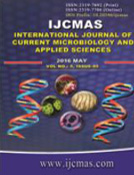


 National Academy of Agricultural Sciences (NAAS)
National Academy of Agricultural Sciences (NAAS)

|
PRINT ISSN : 2319-7692
Online ISSN : 2319-7706 Issues : 12 per year Publisher : Excellent Publishers Email : editorijcmas@gmail.com / submit@ijcmas.com Editor-in-chief: Dr.M.Prakash Index Copernicus ICV 2018: 95.39 NAAS RATING 2020: 5.38 |
This study was focused on the use of Roasted China Clay (RCC) as an alternative adsorbent for the removal of Cr(VI) from aqueous solution. As Cr(VI) above permissible limit is toxic for biological systems and carcinogenic for both animals and plants, therefore it is a matter of great interest to remove it from aqueous systems. Batch experiments were conducted to determine the potential of RCC as an adsorbent by studying the effect of initial metal ion concentration, contact time, adsorbent dose and pH of solution on adsorption of Cr (VI). The maximum adsorption (81.66%) was found at pH 3 with initial metal ion concentration 50 mg/L. Adsorption of Cr(VI) ions depends upon the initial concentration of metal ions. 0.5 g of RCC was able to remove 93.34% of Cr(VI) of conc. 25 mg/L and remove 69.84% of Cr(VI) of conc. 150 mg/L. The value of R2 ≈ 0.9694 and R2 ≈ 0.9329 for Freundlich and Langmuir plots respectively suggested that adsorption of Cr(VI) by RCC obey Freundlich model more appropriately than Langmuir model. Kinetic models plotted for the obtained results showed that the adsorption of Cr(VI) by RCC is of second order reaction. FTIR and SEM analysis had been carried out to study the functional group and surface morphology of the adsorbent. The adsorption capacity of Roasted China Clay was found greater than most of the clay based adsorbents reported. Kinetic studies showed that experimental data was best described by pseudo second order model.
 |
 |
 |
 |
 |